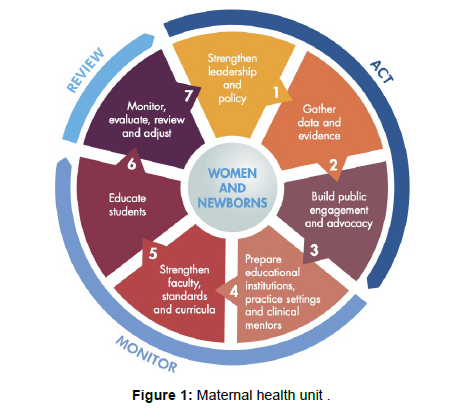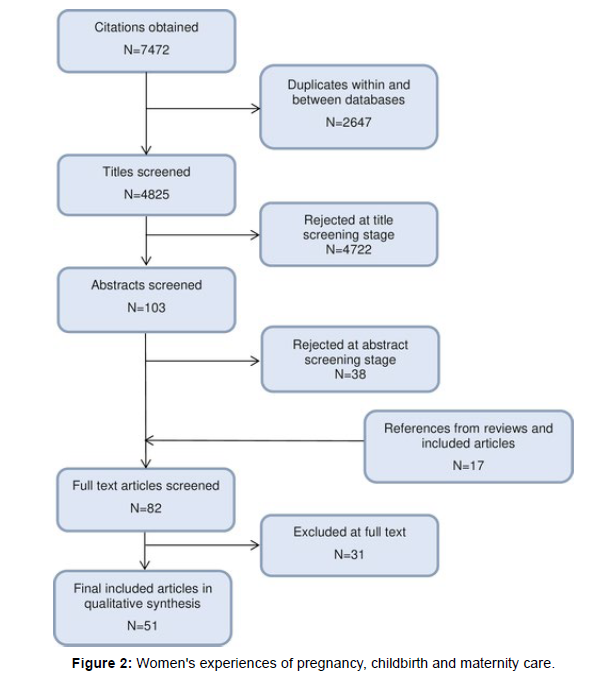Maternity Care for Women: The Importance of Accessible and Quality Healthcare
Received: 03-May-2023 / Manuscript No. JCPHN-23-98089 / Editor assigned: 05-May-2023 / PreQC No. JCPHN-23-98089 (PQ) / Reviewed: 19-May-2023 / QC No. JCPHN-23-98089 / Revised: 22-May-2023 / Manuscript No. JCPHN-23-98089 (R) / Published Date: 29-May-2023 DOI: 10.4172/2471-9846.1000414
Abstract
Pregnancy is a unique time in a woman's life that requires special care and attention. Access to quality maternity care is essential for ensuring a safe and healthy pregnancy, delivery, and postpartum period. In this article, we will explore the importance of maternity care for women and the challenges that many women face in accessing this care.
Keywords
Maternity care; Women's health; Accessible healthcare; Maternal mortality
Introduction
Maternity care is critical for promoting the health and well-being of both the mother and baby. Prenatal care, in particular, is essential for monitoring the mother's health and identifying any potential complications that may arise during pregnancy. Prenatal care also allows healthcare providers to provide guidance on healthy behaviours such as nutrition, exercise, and stress management, which can help to promote a healthy pregnancy [1].
Methodology
During delivery, access to skilled healthcare providers and appropriate medical facilities is essential for ensuring a safe and successful delivery. After delivery, postpartum care is important for monitoring the mother's physical and emotional recovery, identifying any complications, and providing support for breastfeeding and infant care (Figure 1).
Challenges in accessing Maternity care
Despite the importance of maternity care, many women face significant challenges in accessing this care. One of the most significant barriers to accessing maternity care is cost. In the United States, the cost of maternity care can be prohibitively expensive, particularly for women who are uninsured or underinsured. Even for women with insurance, out-of-pocket costs such as deductibles, co-pays, and coinsurance can be a significant burden.
Another significant barrier to accessing maternity care is geographic and transportation barriers. In many rural areas, there is a shortage of healthcare providers, and women may have to travel long distances to access maternity care. This can be particularly challenging for women who live in poverty or who have limited access to transportation.
Finally, many women face systemic barriers to accessing maternity care, particularly women who belong to marginalized groups such as low-income women, women of color, and immigrant women. These women may face discrimination, language barriers, and cultural barriers that make it difficult to access quality maternity care [2, 3].
Improving access to Maternity care
Improving access to maternity care is essential for promoting the health and well-being of women and their families. One approach to improving access to maternity care is to address the systemic barriers that many women face. This may include efforts to address discrimination and bias in healthcare settings, improve language access for non-English speaking women, and provide culturally sensitive care for women from diverse backgrounds (Figure 2).
Another approach to improving access to maternity care is to expand access to insurance coverage. This may include efforts to expand Medicaid coverage for low-income women and children, provide subsidies for insurance premiums, and eliminate out-of-pocket costs for maternity care [3, 4].
Finally, efforts to improve the availability of maternity care in rural areas may include initiatives to recruit and train healthcare providers to work in underserved areas, expand telehealth services to provide remote care, and provide incentives for healthcare providers to practice in rural areas.
Maternity care is essential for promoting the health and well-being of women and their families. However, many women face significant challenges in accessing this care, including cost, geographic and transportation barriers, and systemic barriers. Efforts to improve access to maternity care may include addressing these barriers through policy and system-level changes, expanding insurance coverage, and improving the availability of maternity care in underserved areas. By ensuring that all women have access to quality maternity care, we can promote healthier pregnancies, safer deliveries, and better outcomes for mothers and babies.
Maternity care is a critical component of women's healthcare. It involves the provision of medical and emotional support to women during pregnancy, childbirth, and the postpartum period. The quality of maternity care can have a significant impact on the health and wellbeing of both mother and baby. However, despite the importance of maternity care, women still face many challenges in accessing high-quality care. In this article, we will explore the challenges and opportunities of maternity care for women [5, 6].
One of the most significant challenges women face in accessing high-quality maternity care is the cost. The United States has one of the highest maternal mortality rates among developed countries, and a significant factor is the lack of access to affordable healthcare. Many women cannot afford prenatal care, delivery, and postpartum care, leading to complications that could have been prevented with adequate medical attention.
Another challenge in maternity care is the lack of access to healthcare providers in some areas, particularly in rural and lowincome communities. This lack of access means that some women may have to travel long distances to receive care or may not receive care at all.
Women from marginalized communities such as women of color, low-income women, and immigrant women are more likely to experience disparities in maternity care. These disparities can result in higher rates of maternal mortality, preterm birth, and other adverse outcomes [7, 8].
Opportunities in Maternity care
Despite the challenges, there are also opportunities to improve maternity care for women. One such opportunity is the increasing use of midwives and doulas. Midwives and doulas provide personalized, compassionate care during pregnancy, childbirth, and postpartum. Studies have shown that women who receive care from midwives and doulas have lower rates of interventions such as cesarean sections and are more satisfied with their care.
Another opportunity in maternity care is the use of telehealth. Telehealth allows women to access care remotely, which can be particularly helpful for women who live in remote or underserved areas. Telehealth can also help to reduce the cost of care by eliminating the need for travel and time away from work (Figure 2).
Maternity care can also be improved by increasing access to education and support. Women who are educated about pregnancy and childbirth are more likely to have positive outcomes. Support groups and peer counseling can also provide emotional support to women during pregnancy and postpartum [9, 10].
Maternity care is an essential component of women's healthcare. Accessible and quality maternity care is essential to ensure the health and well-being of both the mother and child. However, in many parts of the world, women still face significant barriers to accessing adequate maternity care. In this article, we will discuss the importance of accessible and quality maternity care and the barriers that women face in accessing it [11].
The importance of accessible and quality Maternity care
Maternity care is crucial to ensure the health and well-being of both the mother and child. Accessible and quality maternity care is essential for ensuring that women receive the necessary prenatal care and support during pregnancy, delivery, and postpartum care. This care includes regular check-ups, ultrasounds, monitoring of the foetus, and education on nutrition, exercise, and childbirth [12, 13].
Discussion
Quality maternity care also includes access to skilled healthcare professionals such as obstetricians, midwives, and nurse practitioners. These professionals are trained to provide comprehensive care during pregnancy, childbirth, and postpartum care, including managing complications and emergencies. Accessible and quality maternity care also includes access to facilities equipped with necessary medical equipment and supplies [14, 15].
Conclusion
Maternity care is an essential aspect of women's healthcare. Despite the challenges that women face in accessing high-quality care, there are also opportunities to improve the quality of care. The use of midwives and doulas, telehealth, and education and support are just a few of the opportunities available to improve maternity care. By working to address the challenges and take advantage of the opportunities, we can ensure that all women have access to the care they need during pregnancy and childbirth.
References
- Mokdad AH, Forouzanfar MH, Daoud F, Mokdad AA, El Bcheraoui C, et al. (2013) Global burden of diseases, injuries, and risk factors for young people’s health during 1990–2013: a systematic analysis for the Global Burden of Disease Study 2013. Lancet 387: 2383.
- Hyde JS (2014) Gender similarities and differences. Annu Rev Psychol 65: 373-98.
- Reeves H, Baden S (2000) Gender and development: Concepts and definitions. London: DFID.
- Snow RC (2008) Gender, and vulnerability. Glob Public Health 3 Suppl 1: 58-74.
- Davis G, Preves S (2017) Intersex and the social construction of sex. Contexts 16: 80.
- Fausto-Sterling A (1993) The five sexes. Sciences (New York) 33: 20-24.
- Heise L, Greene ME, Opper N, Stavropoulou M, Harper C, et al. (2019) Gender inequality and restrictive gender norms: Framing the challenges to health. Lancet 393: 2440-2454.
- Hesketh T.Selecting (2011) sex: the effect of preferring sons. Early Hum Dev 87: 7597-7561.
- Iwamoto DK, Smiler AP (2013) Alcohol makes you macho and helps you make friends: The role of masculine norms and peer pressure in adolescent boys’ and girls’ alcohol use. Subst Use Misuse 48: 371-378.
- González L, Rodríguez-Planas Nr (2018) Gender norms and intimate partner violence. Economics Working Paper Series 1620.
- Albrich JM, McCarthy CA, Hurst JK (1981) Biological reactivity of hypochlorous acid: Implications for microbiocidal mechanisms of leukocyte myelperoxidase. Proc Natl Acad Sci USA 78: 210-214.
- APHA (1998) Standard methods for the examination of water and wastewater. 20th edn American Public Health Association; Washington, DC, USA.
- Bessems E (1998) The effect of practical conditions on the efficiency of disinfectants. Int Biodeterior Biodegradation 41: 177-183.
- Beuvink JM, Spoelstra SF, Hogendrop RJ (1992) An automated method for measuring the time course of gas production of feedstuffs incubated with buffered rumen fluid. Netherlands J Agric Sci 40: 401-407.
- Chmielewski RAN, Frank JF (2003) Biofilm formation and control in food processing facilities. Compr Rev Food Sci Food Saf 2: 22-32.
Indexed at, Google Scholar, Crossref
Indexed at, Google Scholar, Crossref
Indexed at, Google Scholar, Crossref
Indexed at, Google Scholar, Crossref
Indexed at, Google Scholar, Crossref
Indexed at, Google Scholar, Crossref
Citation: David N (2023) Maternity Care for Women: The Importance of Accessibleand Quality Healthcare. J Comm Pub Health Nursing, 9: 414. DOI: 10.4172/2471-9846.1000414
Copyright: © 2023 David N. This is an open-access article distributed under theterms of the Creative Commons Attribution License, which permits unrestricteduse, distribution, and reproduction in any medium, provided the original author andsource are credited.
Share This Article
Recommended Journals
Open Access Journals
Article Tools
Article Usage
- Total views: 884
- [From(publication date): 0-2023 - Mar 12, 2025]
- Breakdown by view type
- HTML page views: 800
- PDF downloads: 84


